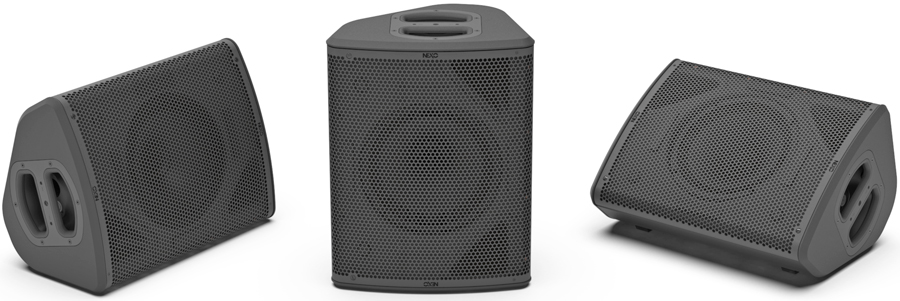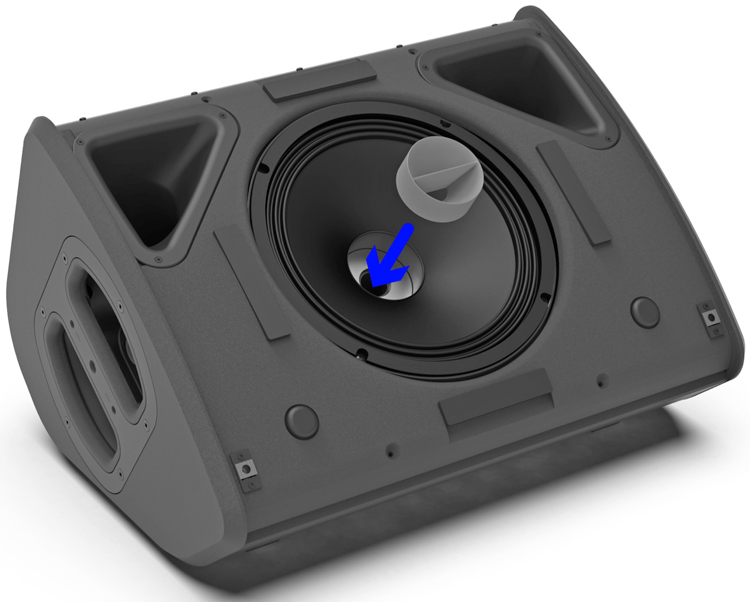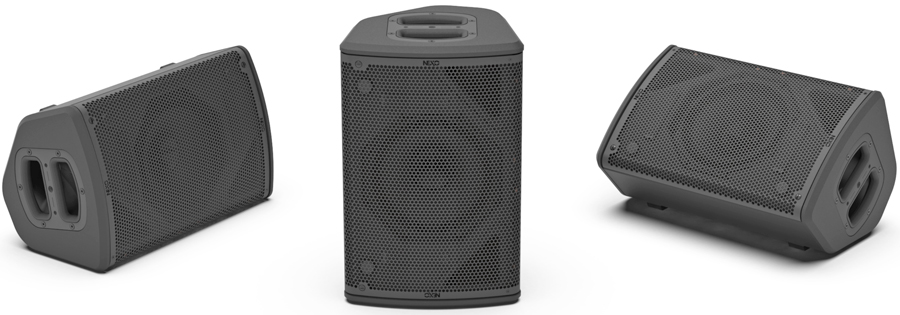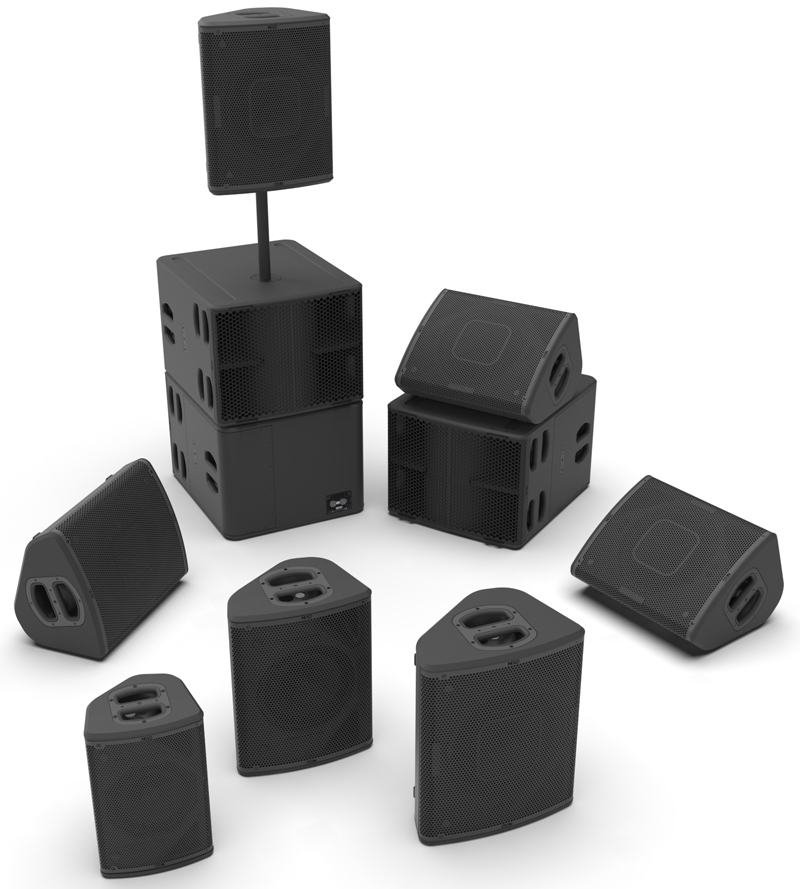When you’re a hit creator, the next logical step is to produce another one. P12 forged the path of the versatile coaxial reinforcement/wedge solution from Nexo. P8 and P10 open new horizons, offering a more compact, lightweight and practical design, to within a few dB and Hertz.

Remember: P12, it’s 20 kg of laminated poplar and birch, a new generation 12 inches long excursion coaxial transducer, a neodymium magnet and a 3” driver, offering a range from 60 Hz to 20 Khz, 138 dB SPL max in passive mode, and 140 dB SPL max in active mode.
Furthermore, P12 offers optional magnetic horn dispersion adapters, bringing the standard 60° x 60° high frequency dispersion to 90° x 40° or 40°~100° x 40°. Let’s sum it up: P12 is 12”, 20 kg and 138 dB.
P10, a passive only loudspeaker, succeeds in the feat of losing 2 dB only of SPL Max at 136 dB, while keeping enough frequency response from 63 Hz to 20 kHz (-6 dB) to perfectly interact with another product of the range, the L15 sub. At the same time, the device can be used as a stand-alone wedge or for close monitoring application.

The long excursion 10” cone and the 1.7” driver are sparkling. However, the size scales down to 50 x 38 x 27 cm and the unit now weights 15 kg.
Another good news: Once the front panel has been removed, the standard 100° x 100° directivity can be modified by inserting an optional magnetic horn dispersion adapter, offering a 110° x 60° angle.
A preset automatically adapts the coherence and the coverage, whatever your choice. The P10 and the L15 sub converge at 63 or 85Hz.
As expected, phase is compliant with the entire low frequency reinforcement range from Nexo, except when the device is used as a wedge, where latency matters. Let’s sum it up : P10 is 10”, 15 kg and 136 dB.
Eventually, P8 is the proof that if you can do more you can do less, and small is not beautiful only, it’s useful as well! Passive only and ridiculously small, P8 offers a more than reasonable response in the low frequency range from 66 Hz to 20 kHz (-6dB), while still delivering a 129 dB SPL Max.
Sizing 43 x 27 x 25 cm and weighting 12 kg, this loudspeaker can be hidden or placed everywhere, especially since its long excursion 10” embeds a 1.5” driver offering a standard 100° x 100° dispersion but can be equipped with the same magnetic and rotative horn dispersion adapter P10 offers as well.

A preset automatically adapts the coherence and the coverage. The P8 and the L15 sub converge at 66 or 85 Hz and again, phase is compliant with the entire low frequency reinforcement range from Nexo, except when the device is used as a wedge, where latency is minimized. Let’s sum it up : P8 is 8”, 12 kg and 129 dB.
P10 and P8 are 8 ohms models, and can be powered through any amplifier brand with the DTD Controller, or via the Nexo NXAMP controller, which can drive one P10 per channel with the 4×1, two with the 4×2 and three P10 per channel of the 4×4 amp. P8 is powered per two through a single channel of the NXAMP 4×1, per three with the 4×2 model and up to four with each channel of the 4×4 amp.

We asked Joseph Carcopino, Nexo’s R&D manager, a few questions about this new and smart coaxial series. He responded to our questions with his legendary frankness.

SLU : Versatility is the key word of this range. Was this a market demand?
Joseph Carcopino : Yes of course, especially since Nexo wants to keep a strong reputation in compact, powerful and versatile speakers.
SLU : Do P12, 10 and 8 have a close color at the top of the spectrum?
Joseph Carcopino : Yes and no, for sure we took care when creating the presets to have a nice consistency within the range, but we’re not going to try to have a 1.5” drive to sound like a 3”.
SLU : Is L15 about to be the reference subwoofer for the P range? Will it offer presets per cabinet?
Joseph Carcopino : Yes, it allows the production companies to harmonize the stocks and to avoid to have multiple references. I think there is nothing better than the size/weight/SPL ratio of the L15. There are no presets per cabinet because they all have the same signature in terms of acoustic phase, everything is perfectly phased on the whole spectrum. On the other hand, there are different cut-off frequencies to adapt to all cases.
SLU : Do the P signs the end of the PS?
Joseph Carcopino : Not at all, the “mythical” PS remain in the catalog and are still produced, nevertheless they should slowly fade over the years after more than 25 years of good service!
SLU : How did you tune the P8 and P10 ? Such like a wedge without asking too much low frequencies, or more like a large band reinforcement?
Joseph Carcopino : We have two types of presets available for each speaker: A FOH preset when doing the PA, either in wide band or in crossover mode, and an ideal monitor preset in wedge mode, with a very flat response, rolled-off in the low end, which provides excellent gain before feedback and a minimal latency, always in wide band or with a high-pass. And I forgot, all this is duplicated as we have 2 types of horn we can install in the cabinet: 100 ° x 100 ° or 110 ° x 60 °.
SLU : When will P8 and P10 be available?
Joseph Carcopino : Expected January 2020.
SLU : Can we imagine a last declination to the bottom and to the top of the P range?
Joseph Carcopino : Why a last one?!
Product presentation video by Joseph Carcopino
More info on the Nexo’s web site








